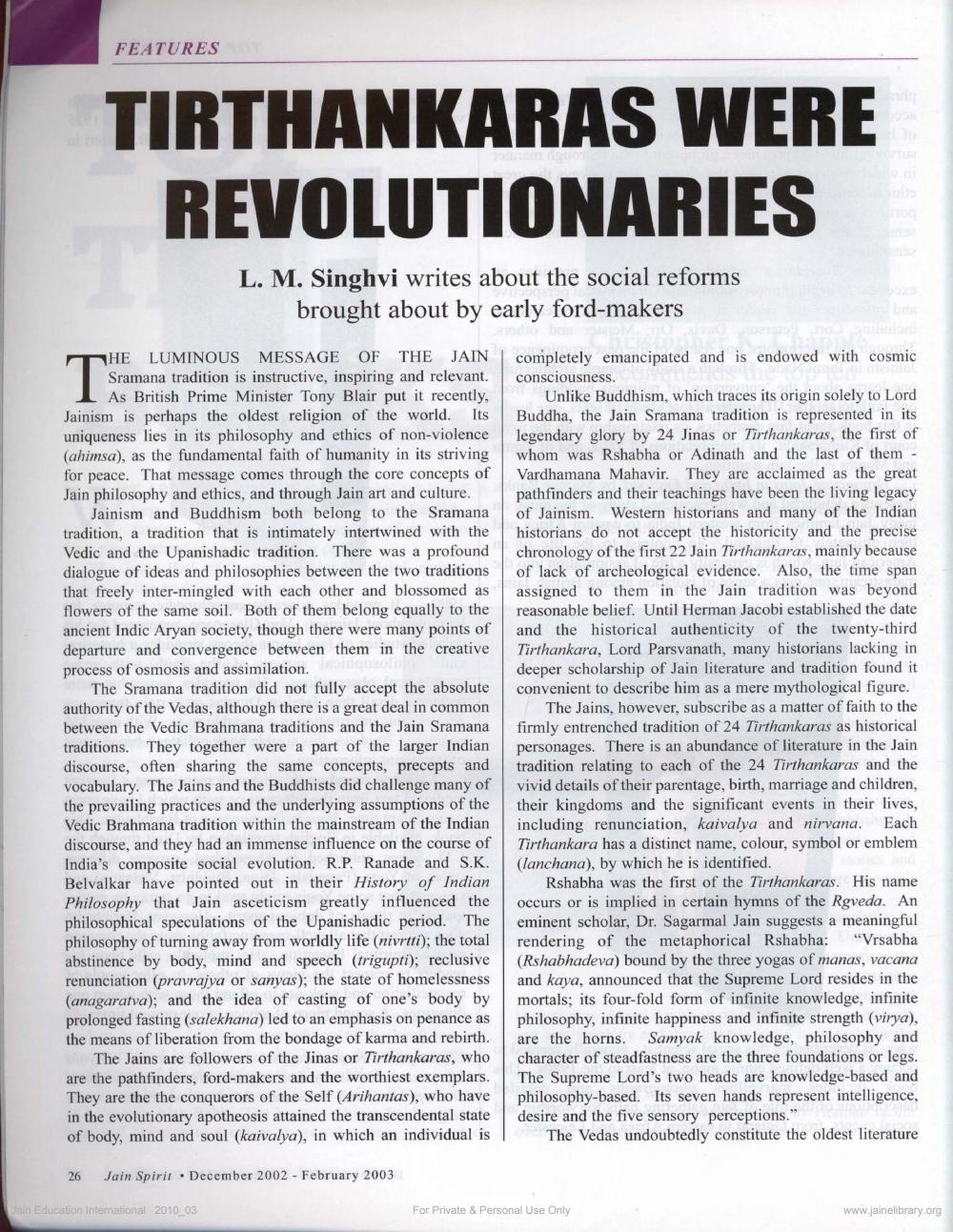________________
FEATURES
TIRTHANKARAS WERE REVOLUTIONARIES
L. M. Singhvi writes about the social reforms
brought about by early ford-makers
THE LUMINOUS MESSAGE OF THE JAIN | completely emancipated and is endowed with cosmic Sramana tradition is instructive, inspiring and relevant. consciousness.
As British Prime Minister Tony Blair put it recently, Unlike Buddhism, which traces its origin solely to Lord Jainism is perhaps the oldest religion of the world. Its Buddha, the Jain Sramana tradition is represented in its uniqueness lies in its philosophy and ethics of non-violence legendary glory by 24 Jinas or Tirthankaras, the first of (ahimsa), as the fundamental faith of humanity in its striving whom was Rshabha or Adinath and the last of them - for peace. That message comes through the core concepts of Vardhamana Mahavir. They are acclaimed as the great Jain philosophy and ethics, and through Jain art and culture. pathfinders and their teachings have been the living legacy
Jainism and Buddhism both belong to the Sramana of Jainism. Western historians and many of the Indian tradition, a tradition that is intimately intertwined with the historians do not accept the historicity and the precise Vedic and the Upanishadic tradition. There was a profound chronology of the first 22 Jain Tirthankaras, mainly because dialogue of ideas and philosophies between the two traditions of lack of archeological evidence. Also, the time span that freely inter-mingled with each other and blossomed as assigned to them in the Jain tradition was beyond flowers of the same soil. Both of them belong equally to the reasonable belief. Until Herman Jacobi established the date ancient Indic Aryan society, though there were many points of and the historical authenticity of the twenty-third departure and convergence between them in the creative Tirthankara, Lord Parsvanath, many historians lacking in process of osmosis and assimilation.
deeper scholarship of Jain literature and tradition found it The Sramana tradition did not fully accept the absolute convenient to describe him as a mere mythological figure. authority of the Vedas, although there is a great deal in common The Jains, however, subscribe as a matter of faith to the between the Vedic Brahmana traditions and the Jain Sramana firmly entrenched tradition of 24 Tirthankaras as historical traditions. They together were a part of the larger Indian personages. There is an abundance of literature in the Jain discourse, often sharing the same concepts, precepts and tradition relating to each of the 24 Tirthankaras and the vocabulary. The Jains and the Buddhists did challenge many of vivid details of their parentage, birth, marriage and children, the prevailing practices and the underlying assumptions of the their kingdoms and the significant events in their lives, Vedic Brahmana tradition within the mainstream of the Indian including renunciation, kaivalya and nirvana. Each discourse, and they had an immense influence on the course of Tirthankara has a distinct name, colour, symbol or emblem India's composite social evolution. R.P. Ranade and S.K. (lanchana), by which he is identified. Belvalkar have pointed out in their History of Indian
Rshabha was the first of the Tirthankaras. His name Philosophy that Jain asceticism greatly influenced the occurs or is implied in certain hymns of the Rgveda. An philosophical speculations of the Upanishadic period. The eminent scholar, Dr. Sagarmal Jain suggests a meaningful philosophy of turning away from worldly life (nivrti); the total rendering of the metaphorical Rshabha: "Vrsabha abstinence by body, mind and speech (trigupti); reclusive (Rshabhadeva) bound by the three yogas of manas, vacana renunciation (pravrajya or sanyas); the state of homelessness and kaya, announced that the Supreme Lord resides in the (anagaratva); and the idea of casting of one's body by mortals; its four-fold form of infinite knowledge, infinite prolonged fasting (salekhana) led to an emphasis on penance as philosophy, infinite happiness and infinite strength (virya), the means of liberation from the bondage of karma and rebirth. are the horns. Samyak knowledge, philosophy and
The Jains are followers of the Jinas or Tirthankaras, who character of steadfastness are the three foundations or legs. are the pathfinders, ford-makers and the worthiest exemplars. The Supreme Lord's two heads are knowledge-based and They are the the conquerors of the Self (Arihantas), who have philosophy-based. Its seven hands represent intelligence, in the evolutionary apotheosis attained the transcendental state desire and the five sensory perceptions." of body, mind and soul (kaivalya), in which an individual is The Vedas undoubtedly constitute the oldest literature
26
Jain Spirit . December 2002 - February 2003
lain Education International 2010_03
For Private & Personal Use Only
www.jainelibrary.org




